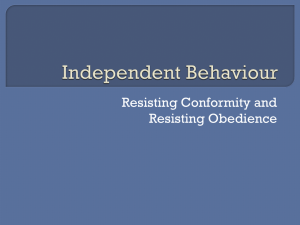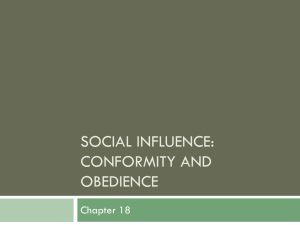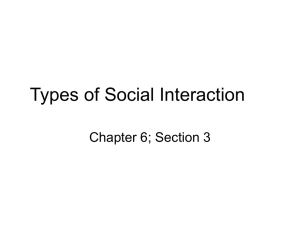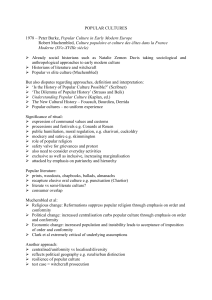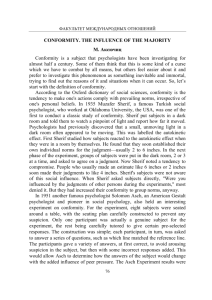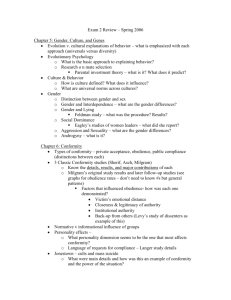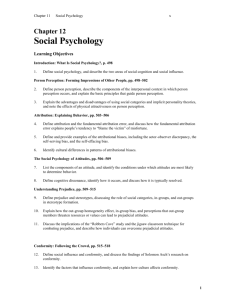26.04.2012 1 Social Influence Social Influence Yielding vs. resisting
advertisement
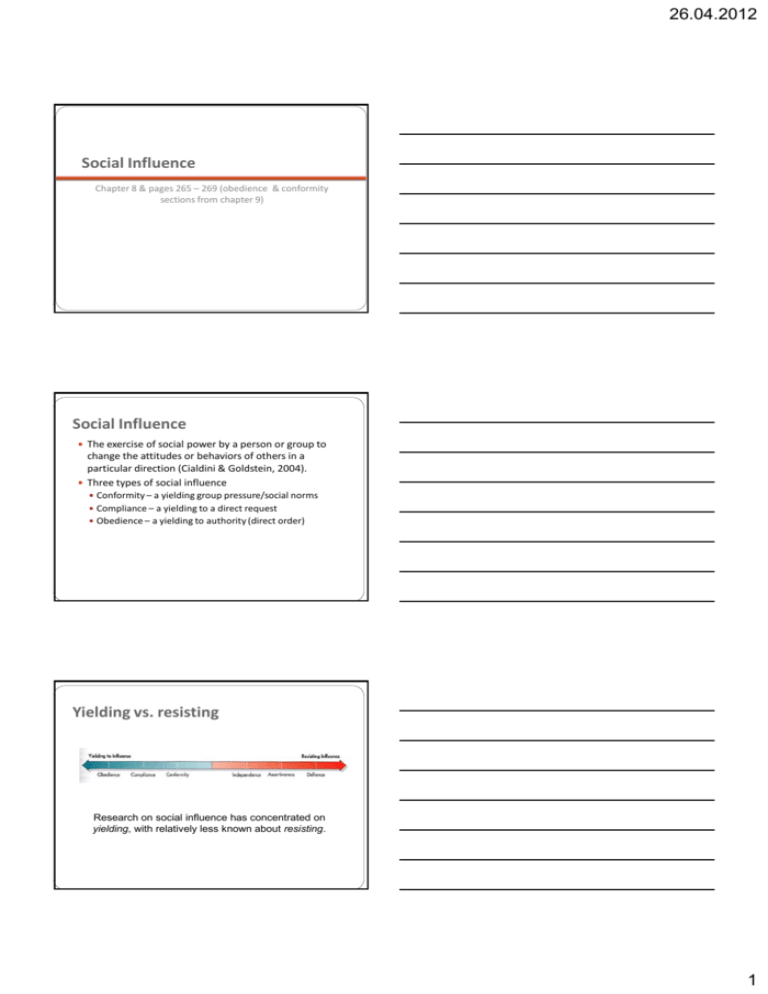
26.04.2012 Social Influence Chapter 8 & pages 265 – 269 (obedience & conformity sections from chapter 9) Social Influence The exercise of social power by a person or group to change the attitudes or behaviors of others in a particular direction (Cialdini & Goldstein, 2004). Three types of social influence Conformity – a yielding group pressure/social norms Compliance – a yielding to a direct request Obedience – a yielding to authority (direct order) Yielding vs. resisting Research on social influence has concentrated on yielding, with relatively less known about resisting. 1 26.04.2012 Social Influence vs. Persuasion Persuasion– influence appeals typically include detailed arguments that is presented to (individual) recipients in a context with minimal social interaction. Aims attitude change Social influence –information is delivered in more complex social settings that may include interactions among participants. Aims a more overall change, in attitudes, beliefs, opinions, values, and behavior Conformity Change in one’s behavior or opinion as a result of real or imagined pressure from a person or group of people. Is it good to be a conformist or non conformist? Labels matter: Non conformist vs. Individualist vs. Deviate vs Slider Conformist vs. Team player Two reasons for conformity Informational social influence (private conformity) Desire to be right ambiguous situation, we look to others e.g., (Sherif) autokinetic effect (1935) Normative social influence (public conformity) Norm Desire to be liked, “fit in” don’t want to be deviant e.g., (Asch) lines experiment (1951) 2 26.04.2012 Conformity: Doing as Others do Sherif’s (1935) autokinetic effect studies A stationary point of light in a dark room appears to move of its on accord. Social norms can lead us to converge with others in estimates of the amount of movement. Ambiguous situation Uncertainty Informational influence Conformity Norms can persist over generations. 8 Sherif’s studies (1936) of norm formation The autokinetic effect is an optical illusion: If you place people in a completely dark room, and let them observe a pinprick of light for some time, they will have the illusion that this light starts moving erratically after some time. Sherif asked individuals to estimate how far the light moved on several trials: Their estimates converged on an idiosyncratic value (typical to that individual). Sherif then asked people to estimate how far the light moved in groups of 2 or 3 Convergence to a group norm 3 26.04.2012 Autokinetic effect: Why did people conform? People need to be certain and confident in the correctness of their actions The situation was ambiguous and uncertain People looked to others to help define “reality” Once developed, the norm persists beyond the immediate situation Informational Social Influence: The Need to Know What’s “Right” Conforming to others because we believe that others’ interpretation of an ambiguous situation is more correct than ours and will help us choose an appropriate course of action see others as a source of information to guide our behavior Norms: acceptable values, beliefs, and behaviors Injunctive Norms – What ought to be done Descriptive Norms – What is normal Informational Social Influence: The Need to Know What’s “Right” May lead to: Private Acceptance :Conforming to other people’s behavior out of a genuine belief that what they are doing or saying is right. Public Compliance: Conforming to other people’s behavior publicly without necessarily believing in what we are doing or saying 4 26.04.2012 Applications Social contagion – the rapid spread of emotions or behaviors through a crowd Mass psychogenic illness – a group suffers from similar symptoms but no physical cause Energy consumption Recycling Reduce drinking /alcohol abuse Cialdini, Reno and Callgren (1990) Procedure: Subjects given chance to drop litter. (Found handbill under windscreen wiper of their car.) What would they do with it? IV1: Clean vs littered environment. IV2: Confederates dropped handbill or just walked past subjects. Results: The effect of the descriptive norm for littering would be enhanced by observing someone else drop litter. Resisting Informational Influence Inappropriate use of others as a source of information can be guarded against by checking information against: Common sense Sense of morality 5 26.04.2012 Asch’s studies (1951) of group pressure What if you are already confident an certain about what is appropriate and correct. Will others’ behaviors still influence you? Asch (1951, 1956) tested whether people would conform in situations in which the group’s judgments were obviously incorrect Asch’s line judgment task: Conformity in nonambiguous situations: A visual discrimination task Standard Comparsion lines a PSYC 204 /SOCI 206 Fall 2009 b c 13 How many conformed? •When alone, > 99% of participants got all the answers correct •Average conformity rate is 33% 35 % of participants showing each level of conformity 30 25 20 15 10 5 0 0 20 1-3 4-6 7-9 10-12 Number of trials on which participants conformed 6 26.04.2012 What’s going on? Unlike Sherif, Asch’s task was not uncertain or ambiguous. However participants seemed willing to ignore the evidence of their own eyes to go along with the groups. Why? Participants said that they knew they were out of step with group, but felt their perceptions were inaccurate and the group was correct. they actually saw the lines as the group did. they did not believe the group was correct but simply went along with the group in order to fit in. BEWARE that the group was composed of strangers – with whom they would have Most of the case, people know that what they are doing is wrong but go along anyway so as not to feel peculiar or look like a fool. Normative Social Infleunce: The need to be liked The influence of other people that leads us to conform in order to be liked and accepted by them. We conform to the group/social norms: Norms: The implicit or explicit rules a group has for the acceptable behaviors, values, and beliefs of its members. This type of conformity results in public compliance with the group’s beliefs and behaviors but not necessarily private acceptance of those beliefs and behaviors. Non-conformers may be dismissed from the group. Physiology of Conformity Recent research found that when participants conformed to a group’s wrong answers, fMRI indicated brain activity in areas for vision and perception. However, when participants chose to give the right answer and disagree with the group, different areas of the brain became active: the amygdala, an area devoted to negative emotions, and the right caudate nucleus, an area devoted to modulating social behavior. 7 26.04.2012 Normative Social Influence in Everyday Life: Women’s body image Conclusions For ambiguous stimuli, norms can develop through reciprocal influence, can be adopted implicitly, and become internalized. For unambiguous stimuli, individuals may conform with the group norms due to fear of social disapproval. Face-to-face situations increase the likelihood of conforming. Even when being accurate is important and the right answer is obvious, some people still conform. Find it difficult to risk social disapproval – even from strangers. Types of Conformity 8 26.04.2012 Automatically Activated Conformity Nonconscious mimicry Have you ever yawned after seeing someone else yawn? Such behavior is conformity we engage in days after birth (Meltzoff & Moore, 1989). Believed to be a survival reflex. Establishes an emotional bond, increasing likelihood of being protected and nurtured by mother. In adulthood, such behaviors foster positive feelings in those we mimic, even when they do not consciously notice. Creates affiliation and rapport, fostering safety in groups. The Chameleon Effect Chartrand and Bargh (1999) Participant and confederate worked on a task together Situational factors Ambiguity of the situation Task difficulty Task importance Motivation Group size Group unanimity Who the other group members are Commitment to the group Accountability Public response vs. Anonymity Culture (collectivistic > individualistic) 9 26.04.2012 30 Who conforms? Low self-esteem High need for social support/ social approval/self-control Low IQ High anxiety Insecurity in the group Perceived low status in the group Women (?) All show interactions with situational factors. Gender 10 26.04.2012 Why do people conform?: Informational influence (private conformity) Desire to be right When the situation is ambiguous When the situation is a crisis When other people are experts Normative influence (public conformity) Desire to be liked, accepted, fear of social disapproval When the group is unanimous When the group size is three or more When the group is important The Minority Can Influence the Majority Minority influence: the process by which dissenters produce change within a group. Those who dissent from majority are often seen as competent but are disliked. Often results in social isolation. Isolation can result in a hesitation in voicing opinions. Minority slowness effect: tendency of those who hold minority opinion to express that opinion less quickly than people who hold the majority opinion. Bir koyun atladı 400'ü takip etti... (radikal, 08.07.2005) DHA - VAN - Gevaş ilçesinin İkizler Köyü'ne ait bin 500 koyun dün sabah saatlerinde köyün yakınlarındaki dağ yamaçlarında otlamaya bırakıldı. Çobanları kahvaltı ettiği sırada başıboş kalan koyunlar, sarp kayalık bölgede otlamaya başladı. Bu sırada koyunlardan biri karşı kayaya atladığı sırada sürü de peşinden atladı. Koyunlar 15 metre derinliğindeki uçuruma düşerek yuvarlanmaya başladı. 400 koyun telef olurken hayvan ölülerinin üzerinden geçen bin 100 koyun ise kurtuldu. Köylüler maddi zararlarının 100 bin YTL civarında olduğunu söyledi. 35 11 26.04.2012 Compliance People make (direct) requests of us all the time. Salespeople, Peers, Friends and Family, advertisements The request may be implicit or explicit, but the target feels pressured to response in the desired way. Honoring those requests helps maintain the social fabric. In the future you may expect that other will also do what you ask them Usually results in covert/public compliance – does not reflect internalization. People are more likely to comply when They are in a positive mood (Forgas, 1998). The reciprocity norm is evoked. The expectation that one should return a favor or a good deed. Commonly used in making sales (free samples). Reasons are provided (Langer, 1978). Langer et al. (1978) Percentage That Complied 100 90 80 70 60 50 40 30 20 10 0 No Reason Reason Given Irrelevant Reason May I Use the Xerox Machine? 12 26.04.2012 Compliance within the framework of persuasion Commonly used tactics: Ingratiation: strategic attempt to get someone like you first, in order to obtain compliance with a request. Reciprocity principle: “treat others as they treat me” If someone does a favor – reciprocate. E.g. Windscreen washers in the traffic. Use multiple steps (usually two) to get others comply with a complex request / big favor Also remember induced compliance within the context of cognitive dissonance 39 “Multiple steps” techniques for inducing compliance 40 Role of power on compliance Compliance is influenced not only by persuasive tactics that people use to make requests, but also by how much power they are perceived to have. Power – capacity or ability to exert influence Different types of power: 41 13 26.04.2012 Obedience to authority Obedience is defined as complying with orders from a person of higher social status within a defined hierarchy or chain of command. An internalized framework of norms, values, customs, procedures specifies that such influence is appropriate. Underlying motives? Classic Obedience study (Milgram, 1965) 43 Milgram’s Obedience Study: 14 26.04.2012 Statements By Shock Recipient: Shock Generator Caution On Amp Meter Amps Slight Shock Moderate Shock Intensity Strong Shock Resistance Very Strong Shock Intense Shock Extreme Shock Danger XXX “That’s out ofExperimenter: here! “LetAll! meGet out me of here! Let me out of here! I told you I had heart trouble. My heart’s bothering me!… “Treat notono response as a wrong response. “Ugh!” …silence... My hearts starting bother now! You have right tome hold me here! “Hey! This Really Hurts!” Get me out of here, please! out!” Let me out! Let ….Let me out!me Let me out!”level of shock.” Deliver the next higher How many obeyed? Predicted versus actual levels46of shock given to a victim 47 15 26.04.2012 Reducing Obedience: 1. by increasing the obviousness of the learner’s plight Victim not seen or heard ..... 66% Victim not seen but heard ....62% Victim one meter away ........40% Victim’s hand placed on shock plate....30% 2. Reducing the authority or influence of the experimenter At Yale university....... 65% At a run-down office ....48% With experimenter giving orders via telephone ... 25% With confederates of experimenter refusing to give shocks.... 10% Nothing the victim did or say had any effect on the % of obedience! Factors that increase obedience Legitimacy of the authority (vs ordinary person) Greater distance from the victim – touch - different room Closer supervision by authority (absent, present, remindful) Presence of people who modeled obedience Lack of dissent in group Gender, age, education not relevant Cross-cultural replications Country USA Subjects % obedient Male general population 65 Female general population 65 USA Students 85 Italy Students 85 Germany Male general population 85 Australia Male students 40 Female students 16 UK Male students 50 Jordan Students 62 Spain Students 90 + Austria General population 80 50 The Netherlands General population 92 16 26.04.2012 Why did people obey? Obedience to a legitimate authority is a norm Initial commitment by administering trivial levels of shock Self-justification. No personal responsibility for harming the learner. Emotional distance of the victim Voluntary participation of the victim Closeness, legitimacy and responsibility of the authority Institutional authority Do these effects occur in "real life"? Hofling et al. (1966) Nurses were telephoned by a doctor they didn't know. They were ordered to administer a nonprescribed drug in double the maximum dosage to a patient. 22 nurses were called. Results: 21 out of 22 nurses (95.5%) followed the doctor's orders. Would people still obey today? 29 men and 41 women, age range 20-81, American with different ethnic backgrounds. Replicated Milgram’s procedure – only let the subjects administer shocks up to 150 V Previously, experts & psychiatrists had guessed nobody would go beyond 150V 70% continued after 150 volts 66.7 % of men and 72.7 % of women Ref: Burger, J. M. (2009). Replicating Milgram: Would people still obey today? American Psychologist, 64, 1-11. Also see: http://www.youtube.com/watch?v=y6GxIuljT3w 17 26.04.2012 Implication of Milgram study: abuses at Abu Ghraib Why did American soldiers commit abuses at Abu Ghraib and record their crimes on film? For "psy-op reasons," according to Private Lynndie England (above), who insists that she was following orders from "persons in my higher chain of command." To sum up: Obedience to legitimate authorities is normative Obedience serves numerous productive functions. Necessary for some social order May be educative, refer to acts of charity and kindness But may also be destructive. 4 distinctions between conformity and obedience: 1. 1. Conformity Peer influence 2. Performance of a modeled act 3. Implicit pressure 4. People deny conformity Obedience Hierarchical structure 2. Performance of a required act 3. Explicit pressure 4. People acknowledge authority figure 18 26.04.2012 A unified understanding of social influence: Social Impact Theory The amount of influence others have in a given situation is a function of three factors (Latané ,1981) Strength importance of the group for you. power of the authority Immediacy How close is the group/authority in space and time during the influence attempt. Number 3 or more (does not matter, if it is 5 or 6 etc.) 19
